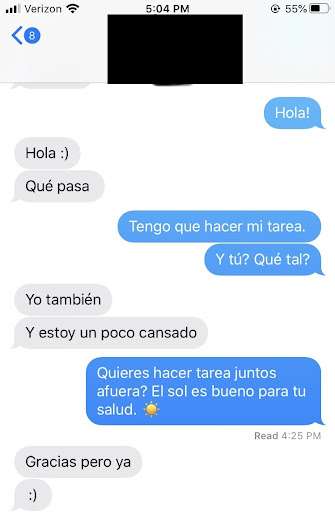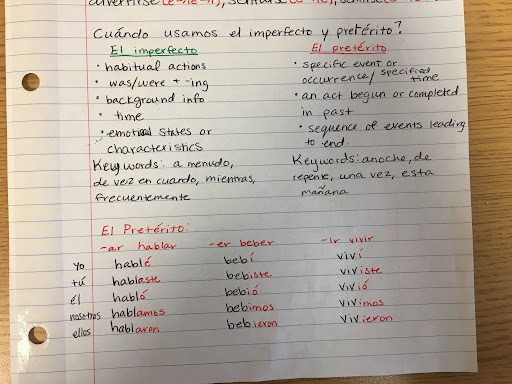From Foreign Language to Familiar Language: My Journey through UNC Spanish Classes
By Katy, a Peer Tutor
Coming to UNC, I thought that I had a relatively good grasp on Spanish, having taken Spanish classes for 5 years from 6th grade to 10th grade. Since it had been two years since I had taken Spanish, I decided to enroll in Spanish 105 for my first semester thinking it would be muy fácil (very easy). To my surprise, very little English was spoken throughout the entire semester. So not only did I have to switch my STEM-centered brain to grasping grammar concepts but I had to adapt to directly understanding words in Spanish instead of translating to English in my head. This was a challenge for me but along the way I picked up some handy study habits that helped me to succeed.
In my high school Spanish classes, speaking Spanish was never something that was emphasized, so I identified that as my weakest area and decided to develop that first. I thought about reaching out to people in Spanish class to try talking to in Spanish, but in all honesty that was daunting for me as I was still adjusting to college life. So instead, to accomplish my goal of improving my speaking skills and not going too far outside of my comfort zone, I started small.
Texting in Spanish
My first step to improving my speaking skills was texting my sister and mom in Spanish, modeling a conversational style that I would use as if having a verbal conversation with someone. It helped that they knew Spanish as well and were able to respond back to me.
Study Buddy
Once I became more comfortable with texting in Spanish and became more familiar with the people in my class, I reached out to one classmate to ask about studying together. We then studied together once a week outside of class from then on and we would practice speaking Spanish after class as we walked home together. One way we would engage in Spanish on our walk home is we would give each other one verb and have each person fully conjugate the verb in a certain tense and use it in a sentence. Additionally, we would make shared study guides in English reviewing the new Spanish grammar content introduced each week. I think that it was very helpful for me to have a study partner to help keep me accountable on a study schedule. It helped me stay motivated and gave me something to look forward to because it was time that I could not only practice Spanish but also hang out with a friend. I think that both of our motivational attitudes encouraged one another because we found a good balance between visiting during study sessions and getting work done.
Colorful Notes
When it came to grammar concepts, repetition and color-coded tables were my best friends. Before a quiz or an exam, I would repeatedly write out all the verb endings for various tenses that were going to be on that particular assessment. Additionally, I wrote out all of the verb endings in red to help my eyes pay special attention to them and help my brain make a special note of them. Sometimes I did this with my study buddy just to have some supportive and motivational company. As I learned new verbs and grammar concepts I would try and incorporate it into my text messages to impress my sister and mom.
Internet Resources
Another resource that I found very helpful was the internet. There are tons of foreign language YouTube videos, children’s songs and even pop music in a variety of languages. Oftentimes my study buddy and I would share websites we found helpful or even work on online practice quizzes together when we studied. I found it not only beneficial to my Spanish vocabulary but also a lot of fun to listen to songs in Spanish. One of my favorite songs to listen to was “Billy La Bufanda.” There are lots of children’s songs that can be helpful when learning basic grammar tenses, like present tense, and general vocabulary topics, like clothing and food. When I wanted to listen to more contemporary songs, Enrique Iglesias was always my first choice.
Furthermore, before every test I always utilized online practice tests in order to practice certain grammar topics. Spanishdict and StudySpanish were my go-to sites for practicing. Additionally, I referred to the Learning Center handouts for tips on time management and study strategies.
During my first Spanish class at UNC, I heard others talk about how difficult language classes are at UNC, and it made me question whether I could even finish the gen-ed language requirements here. To help me tackle this fear, I remembered that one of my high school Spanish teachers had a poster on her wall with a list of motivational sayings in Spanish. My favorite one that I can remember was, “Nunca es tarde para aprender” (It’s never too late to learn). I kept this phrase in mind as I went to class each day. As the semester went on and I picked up some new study strategies and tips, I slowly became more confident in my ability to continue taking Spanish.
This blog showcases the perspectives of UNC Chapel Hill community members learning and writing online. If you want to talk to a Writing and Learning Center coach about implementing strategies described in the blog, make an appointment with a writing coach, a peer tutor, or an academic coach today. Have an idea for a blog post about how you are learning and writing remotely? Contact us here.




